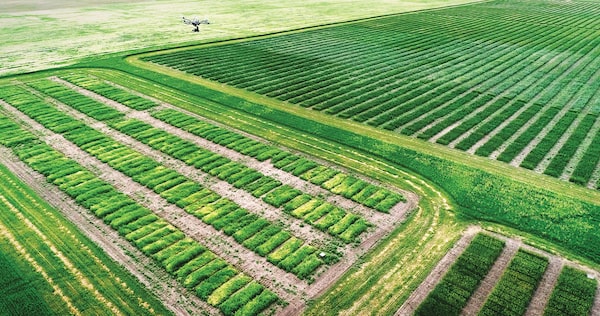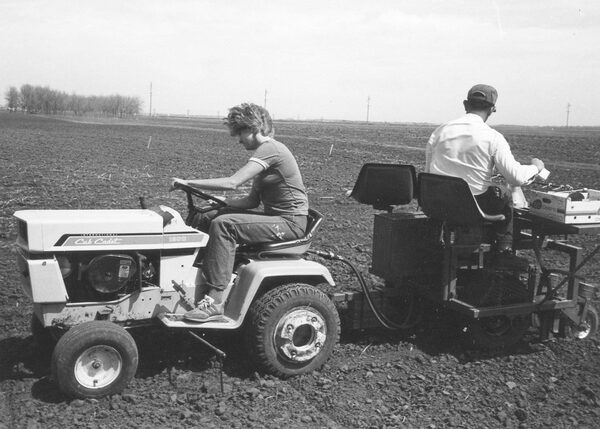
Efforts have yielded results in technology innovation.SUPPLIED
2021 marks a major milestone for the University of Saskatchewan’s (USask) Crop Development Centre (CDC) as it looks back on 50 years of reshaping global agriculture.
“Achievement” is the key word CDC director Dr. Curtis Pozniak uses to describe the half-century of innovation – and there is a long list of important contributions of CDC scientists to global food security, for example, by releasing more than 500 crop varieties and shaping agricultural practices to help producers diversify and farm more productively.
“The University of Saskatchewan’s Crop Development Centre provides research the world needs – giving people the basics of life by creating healthier, hardier varieties of field crops,” says Dr. Baljit Singh, USask’s vice-president, Research. “The centre is part of an innovation ecosystem at our university and in our province that embraces discovery and encourages partnerships with a diverse variety of collaborators to improve global food security.”
In addition to the CDC, USask is home to many other research organizations working to advance innovative solutions for issues related to food and water security. Among them are the Global Institute for Food Security, the Global Institute for Water Security, the Livestock and Forage Centre of Excellence, and more centres where researchers are collaborating to ensure worldwide access to two of the necessities of life on this planet: food and water.

Crop development breakthroughs, including those led by Dr. Curtis Pozniak.SUPPLIED
Tackling today’s challenges of climate change and evolving consumer priorities
High-yielding crop varieties with resistance to disease and pests remain important goals, especially in the face of climate change. But crops also have to be adapted to changing market demands, as the world’s population rises and consumers prioritize choices that are healthier and more ecologically sustainable. Crops must also evolve to suit changing production and processing methods.
“As plant breeders, we have a lot to think about in terms of what traits we are targeting,” says Dr. Pozniak.
In striving to breed better varieties more efficiently, Dr. Pozniak has led the way in the use of new technologies in wheat breeding. He and fellow wheat breeder Dr. Pierre Hucl headed the Canadian Triticum Advancement through Genomics (CTAG) project, helping an international consortium sequence the wheat genome.
Genome sequencing provides “the genetic blueprint of the varieties that we’re working with. The blueprint helps us identify genes, and to create molecular testing tools that we can use to improve efficiency in selection,” Dr. Pozniak explains. He co-led the follow-up project CTAG2, sequencing 16 different wheat varieties.
In addition, CDC scientists have worked on sequencing pea, lentil, chickpea, tepary bean, barley, oat and flax genomes.

The University of Saskatchewan’s agricultural research started decades ago, as illustrated by the 1979 image of Dr. Al Slinkard and a summer student on a tractor and seederSUPPLIED
From helping local farmers adapt to providing global solutions
A changing world led to the CDC’s creation. In the late 1960s, a global glut drove down the price of wheat, the crop Saskatchewan farmers relied on most heavily. Meanwhile, the USask Crop Science Department was looking for research opportunities. With funding from the National Research Council and the provincial government, the CDC started in 1971.
Some early game-changers established the CDC’s reputation nationally and internationally. Within the first decade, pulse breeder Dr. Al Slinkard selected two new green lentil varieties (the large-seeded Laird and small-seeded Eston). By the late 1980s, Laird had become the most widely grown lentil variety in the world. Lentils went from a minor crop to a major protein commodity in Saskatchewan, where nearly all of the country’s production comes from today. And Canada itself became the world’s top producer and exporter.
The malting barley variety Harrington captured worldwide attention following its release in 1981, appealing to brewers as far away as China and becoming a leading choice of North American producers. Developed at the CDC by Dr. Bryan Harvey with help from Dr. Brian Rossnagel, Harrington was the first variety suited to growing conditions in Western Canada that produced the high-enzyme activity in demand for two-row malting barley for beer.
CDC varieties also helped Saskatchewan become Canada’s top producer of flax and peas. Other releases include the first Canadian hull-less barley, the first hairless canary seed, along with new varieties of hard red spring wheat, durum and faba beans.
The University ofSaskatchewan’s CropDevelopment Centre provides research the world needs – giving people the basics of life by creating healthier, hardier varieties of field crops.
Scientific insights shaping agricultural practices
Early on, CDC scientists promoted the idea of seeding winter wheat into stubble. An insulating blanket of snow, trapped by stubble, helped fall-seeded winter wheat survive in Saskatchewan’s harsh climate.
“Keeping the snow uniformly on the field was the key,” says USask wheat breeder Dr. Brian Fowler.
However, limitations to no-till had to be solved, including the lack of effective seeding equipment and agronomic information, such as crop residue management, fertilizer application and seed placement. In the 1970s and ’80s, the program worked closely with equipment manufacturers, farmers and conservation groups to overcome these limitations.
The innovative approach to no-till farming has been a game-changer for agriculture productivity across the globe.
CDC research has also led to the replacement of vast acres of unproductive summer fallow with productive crops.

Efforts have yielded results in technology innovation.SUPPLIED
A solid foundation for envisioning the future
Over the years, contributions to the CDC from government agencies, industry partners, producer organizations and donors have paid off: for every $1-million invested in CDC plant breeding, producers make more than $7-million, according to a 2016 economic impact report.
Yet one thing in crop breeding remains unchanged. It still takes eight to 10 years to develop a new variety, Dr. Pozniak notes.
Peering into the future to identify what will be in demand is “what makes it so fun” – as well as highly important for feeding a growing world population.
Advertising feature produced by Randall Anthony Communications. The Globe’s editorial department was not involved.